M.B. Dallocchio's Blog, page 2
May 4, 2015
Haunting Habbaniyah & Patient Profile Case # 17 Reported Sexual Assault at Corregidor
 Eucalyptus trees in Habbaniyah, IraqThat makes a man go mad for all his goodness of reason, a rage that rises within and swirls like smoke in the heart and becomes in our madness a thing more sweet than the dripping of honey. -Homer, Book XVIII of the Iliad
Eucalyptus trees in Habbaniyah, IraqThat makes a man go mad for all his goodness of reason, a rage that rises within and swirls like smoke in the heart and becomes in our madness a thing more sweet than the dripping of honey. -Homer, Book XVIII of the Iliad In a 7-ton high-back I was on my way to counsel a female in a reported sexual assault case in Al Taqaddum (TQ). I had gone against the wishes of COL Abigail and snuck off anyway. I knew if LTC Platoni was there, she would have gladly sanctioned it and told her of it as well. I slept in a mouse-infested tent with the laziest cat I had ever seen and did my duty. I returned in early September after no commo with Ramadi since Arnold had shut off the ringer (although he denied ever doing so and the witless MAJ who was with him didn’t even know how to use a DNVT).
Following the directions of the Brigade Commander back in Ramadi, I met up with a chaplain in TQ who could help me find the Soldier who survived a recent incident involving sexual assault. The Soldier was apparently outside the wire for a few hours according to an officer in her company so the chaplain and I wandered around Habbaniyah until it was time to meet her.
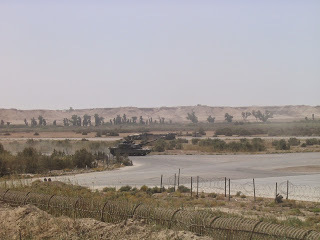 Habbaniyah, IraqIf there is anything that transports me back to Al Anbar Province, it's eucalyptus trees. The smell of the leaves and how my sinus problems went away upon our arrival into this troubled, chaotic region provided a sense of relief, an ability to breathe.
Habbaniyah, IraqIf there is anything that transports me back to Al Anbar Province, it's eucalyptus trees. The smell of the leaves and how my sinus problems went away upon our arrival into this troubled, chaotic region provided a sense of relief, an ability to breathe.The chaplain, a kind and enthusiastic officer, proved to be quite the history buff with an extensive knowledge of Iraq history, particularly with events that occurred in the early part of the 20th century. Details that are often omitted from war plans, history repeating itself time and again.
Overlooking Habbaniyah from the top of one of the few multi-level buildings, he spoke about how German and British troops fought each other here in the 1930’s which echoed the fight over oil that we so often hear today.
 Abandoned Theater in HabbaniyahWe then walked to an old abandoned theater adorned with murals and film ads across the floors caked in sand and mouse droppings. On the other side of the theater was a mural painted after the Iran-Iraq war, depicting the Ayatollah of Iran as decapitated with a Star of David on his turban. Apparently, anyone considered an enemy in Iraq, was also accused of being a Zionist, one who poses a threat to Arabs. Considering Iran's history with Israel, I found this mural to be odd, yet I had to take a photo. Otherwise, who would believe the irony or scapegoating?
Abandoned Theater in HabbaniyahWe then walked to an old abandoned theater adorned with murals and film ads across the floors caked in sand and mouse droppings. On the other side of the theater was a mural painted after the Iran-Iraq war, depicting the Ayatollah of Iran as decapitated with a Star of David on his turban. Apparently, anyone considered an enemy in Iraq, was also accused of being a Zionist, one who poses a threat to Arabs. Considering Iran's history with Israel, I found this mural to be odd, yet I had to take a photo. Otherwise, who would believe the irony or scapegoating?All around us were old movie reels featuring Egyptian, French and American films and rows upon rows of beautiful white leather seating that were caked with even more dirt, sand, and dust. Frozen, forgotten by time.
 Abandoned Theater
Abandoned Theater
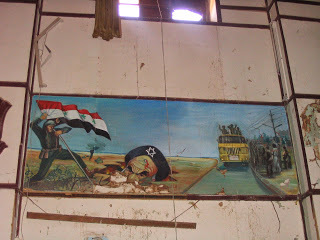 Iran-Iraq War MuralYou could close your eyes and just imagine how beautiful this place must’ve been in its heyday, but when you open them back up, you see the ever-present in Iraq: beauty that’s been thoroughly dismembered, punched in the eyes, and left for dead.
Iran-Iraq War MuralYou could close your eyes and just imagine how beautiful this place must’ve been in its heyday, but when you open them back up, you see the ever-present in Iraq: beauty that’s been thoroughly dismembered, punched in the eyes, and left for dead.As I looked around the theater, I thought of how the deployment had been thus far. I contemplated on the repeated assaults upon Iraq and beauty that kept getting buried with trauma after trauma, without mercy, without end.
Forget the beautiful architecture or the morale and welfare material, stepping outside provided a breath of history that was now muted, struggling to maintain circulation, a pulse. Wandering inside these ruins around the country made me wonder where the mercy, benevolence, and forgiveness wandered. Iraq was, indeed, beautiful, but she was being crushed to death.
So many back home have this narrow view of Iraq as being an enabler of terrorism, but these groups didn't exist in-country during Saddam Hussein's rule. Many of these radical, Salafist groups hailed from its neighbor to the south: Saudi Arabia. After all, Saudi Arabia couldn't see predominantly Shia Iraq succumb to a partnership with predominantly Shia Iran. You'll never hear of Saudi Arabia's atrocities in Iraq. Not so long as we're buying oil from them and that they have a significant percentage of our nation's assets in their grasp. This war felt like a well-orchestrated dog fight, with Saudi royalty and US politicians profiting big off of the turmoil of a destabilized Iraq.
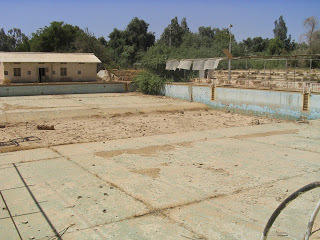 Empty Pool Near ChurchAfterwards we walked to another location that was on the edge of this small FOB supposedly where Winston Churchill once met with other world leaders when this place used to be a Royal British Air Force base. We ended up reaching an old Anglican church and a place surrounded with pomegranate trees that led to an emptied Olympic-size swimming pool. Empty, abandoned, and previously brutalized. These deteriorating buildings served as a constant reminder around this province that hope was scarce, and the people praying here long ago have since fled for their lives.
Empty Pool Near ChurchAfterwards we walked to another location that was on the edge of this small FOB supposedly where Winston Churchill once met with other world leaders when this place used to be a Royal British Air Force base. We ended up reaching an old Anglican church and a place surrounded with pomegranate trees that led to an emptied Olympic-size swimming pool. Empty, abandoned, and previously brutalized. These deteriorating buildings served as a constant reminder around this province that hope was scarce, and the people praying here long ago have since fled for their lives.  Empty Anglican ChurchThe acoustics inside the Anglican church were incredible though. The chaplain and I stood inside for a few minutes and sang, anything and everything, experimenting with the echoes and melodies drifting through the empty room, a place that both time and God seemed to have left behind.
Empty Anglican ChurchThe acoustics inside the Anglican church were incredible though. The chaplain and I stood inside for a few minutes and sang, anything and everything, experimenting with the echoes and melodies drifting through the empty room, a place that both time and God seemed to have left behind.Throughout this impromptu stroll, I couldn't help but feel that persistent presence, the energy of events and people who've passed through these buildings and landscapes from another time. Ghosts of Habbaniyah and the Anbar Province are things many of us only talk about in whispers and vague references to avoid addressing the discomfort of some of these locations. Death, destruction, and hopelessness was everywhere. There was no escape, and the dying beauty before you appears beyond help and there is nothing you feel you can do to stop the pain.
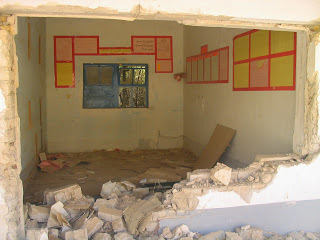 Bombed SchoolhouseWe walked through a bombed out and deserted Iraqi elementary school. Bullet holes, mortar damage, and old school material in Arabic adorned this former place of learning accompanied with that extra sense of unavoidable despair.
Bombed SchoolhouseWe walked through a bombed out and deserted Iraqi elementary school. Bullet holes, mortar damage, and old school material in Arabic adorned this former place of learning accompanied with that extra sense of unavoidable despair.Classrooms were filled with homework, blueprints of former British buildings dating back to the 1930’s, and visual aids for children. We live in a strange world.
Next to one of the buildings at the school was a miniature cemetery, neglected. I knelt down and touched the ground, wondering what or who lies beneath.
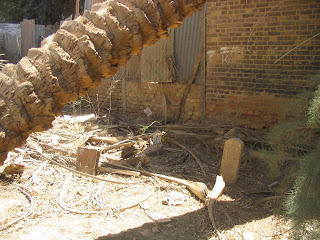 CemeteryWhen the time arrived, I asked around where the Lioness from Corregidor might be, the one who had reported the sexual assault.
CemeteryWhen the time arrived, I asked around where the Lioness from Corregidor might be, the one who had reported the sexual assault.According to a few other Soldiers, she was at the chow hall on the other side of Habbaniyah eating with a few of her battle buddies. I had her name written on a piece of scratch paper which I immediately folded and put in my pocket as I neared the mess hall. I had a physical description of her and I didn’t want to alarm anyone around her that someone from combat stress was looking for her.
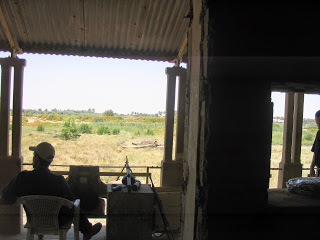 Defense Contractors in Habbaniyah
Defense Contractors in HabbaniyahWe spoke only briefly and she informed me that everything was fine. She apparently thwarted the attack by, reportedly, an Iraqi soldier, and beat him with her rifle. Others intervened and that soldier was later "disappeared" by his comrades. I left my contact information with her, stating that she could reach out if she ever needed anything. She agreed.
En Route to Iraq: Memories of Kuwait 2004
******************************************************************************************
As I woke to see the flight map taking us past Turkey and into Iraq, I sat up in my seat and opened the window shade to complete darkness as we crossed into the country where we’d stay for a year. I stared out the window for hours at this point, turning on my iPod and listening to Arabic music tracks, getting in the mindset that I wasn’t anywhere near home anymore and this is the language I’d hear throughout the deployment.
The plane was dark, littered with a few reading lights still on throughout the cabin. As we flew over Baghdad, the lights were so brilliant as this sprawling desert city shone like thousands of stars on a clear night.
 Oil fields of Iraq as seen from our airplaneWhile we flew over what looked like Babil on the map in my Iraqi history book, Oswald stopped by my aisle and asked what I was looking at. I pulled out my ear buds and told him what location we should be flying over, and then he said, “We’re flying over ancient Mesopotamia.”
Oil fields of Iraq as seen from our airplaneWhile we flew over what looked like Babil on the map in my Iraqi history book, Oswald stopped by my aisle and asked what I was looking at. I pulled out my ear buds and told him what location we should be flying over, and then he said, “We’re flying over ancient Mesopotamia.”The sun was coming up, turning the sky a combination of pink, purple, and orange.
“I know, it’s all so surreal, isn’t it?” I said, still looking out the window in wonder.
“Yeah. Friggin’ amazing.”
As we approached Kuwait, I began taking pictures as I caught sight of the Gulf as Natacha Atlas songs were streaming through ears. As we began to descend, the song Ashwa began playing while I took a video of the landing, this all seemed like a movie to me that I was simply observing and not participating. Perhaps this was a way of detaching from the harsher realities about to set in.
Natacha Atlas - Ashwa (Lyrics Translation):
I'm building a body from balsam and ash
I'm building a body with no god attached
I'm building a body from blueprints in Braille
I'm building a body where our design had failed
There's a book full of plans at the feet of poor Atlas
Titled "For Man" But the architects only drew blanks
Now there's nowhere to go
But go back, go back, go back, go back.
 Flying into KuwaitWe flew over white tents in the desert as well as expansive highways as we drew nearer to the skyline of Kuwait City. Suddenly the wheels of the aircraft touched ground and we were finally in the Middle East. Upon exiting the aircraft, the chilly air embraced us we walked toward two curtained Mercedes Benz buses which drove us toward the next stop: an ammunition site.
Flying into KuwaitWe flew over white tents in the desert as well as expansive highways as we drew nearer to the skyline of Kuwait City. Suddenly the wheels of the aircraft touched ground and we were finally in the Middle East. Upon exiting the aircraft, the chilly air embraced us we walked toward two curtained Mercedes Benz buses which drove us toward the next stop: an ammunition site.We pulled up to the site where several other units were unloading ammo cans from larger containers and carrying them to their buses and a sergeant soon came aboard our bus and asked for volunteers. Before anyone could say anything, Chaplain Parris who was sitting in the middle at the very back of the bus, grasping his personal bag for dear life quickly interjected, “Get Brookfield!”
I took one quick look at him wondering what the hell inspired him to volunteer me before I could even say anything. “Alright, well would you mind watching my bag for me, Sir?” I asked as I got up to walk out of the bus.
He nodded in agreement before I turned to carry the unit’s ammunition with SSG Corey and a few other Soldiers, still clutching his bag. You would think a religious man would, oh I don’t know, have more faith in God and be far less afraid?
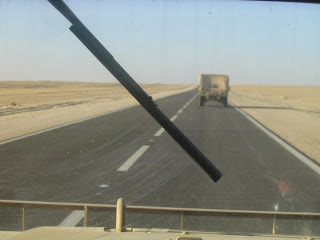 KuwaitWe drove for what seemed like hours across a barren desert landscape with cars speeding by us honking horns, a few cars full of men showing our bus the middle finger. As one of the twenty-something Kuwaiti men screamed what could only be sweet obscenities while showing our bus the finger, I stared at him for a while until he saw me looking back. I then showed him buck-teeth and crossed my eyes, wagging my head back and forth, but before I knew it they took off like lightning down the highway.
KuwaitWe drove for what seemed like hours across a barren desert landscape with cars speeding by us honking horns, a few cars full of men showing our bus the middle finger. As one of the twenty-something Kuwaiti men screamed what could only be sweet obscenities while showing our bus the finger, I stared at him for a while until he saw me looking back. I then showed him buck-teeth and crossed my eyes, wagging my head back and forth, but before I knew it they took off like lightning down the highway.SSG Moran looked at me and shook her head laughing, “You dork!”
We both laughed before COL Abigail suddenly screamed in a panic, “SHUT ALL THE CURTAINS!” from the back where Chaplain Parris sat.
We arrived at a place called Camp Virginia where a sea of white tents covered flat cold sand spanning for what looked like an endless, chilly plane. There were all sorts of units and international military personnel there, playing volleyball, eating at the fast food pizza stand, walking to and from various spots of the camp. Our tents were side by side and our unit had the front of one of the tents furthest in the back of the camp. We settled onto various vacant cots in a really cramped large tent and were ready to get the show on the road.
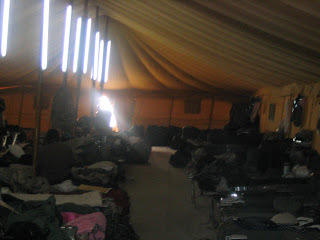 Camp Virginia, KuwaitWith crowding and freezing temperatures when the sun would go down in the desert, I huddled in my sleeping bag like a nervous Chihuahua and shivered myself to sleep as I slept closest to the entrance. I couldn’t believe how cold it was. I remember one of the 3ID guys saying when he was in Kuwait; he was the coldest he had ever been in his life. There was something resembling an A/C unit in each corner of the tent but all were fairly weak and I wouldn’t have known if the heating element really worked or not. But I was still very eager to get to Iraq as this was just another step toward our destination: Camp Ramadi.
Camp Virginia, KuwaitWith crowding and freezing temperatures when the sun would go down in the desert, I huddled in my sleeping bag like a nervous Chihuahua and shivered myself to sleep as I slept closest to the entrance. I couldn’t believe how cold it was. I remember one of the 3ID guys saying when he was in Kuwait; he was the coldest he had ever been in his life. There was something resembling an A/C unit in each corner of the tent but all were fairly weak and I wouldn’t have known if the heating element really worked or not. But I was still very eager to get to Iraq as this was just another step toward our destination: Camp Ramadi.
April 25, 2015
Steer Clear of Centennial Toyota in Las Vegas
Beware of this dealership:
Centennial Toyota
6551 Centennial Center Blvd
Las Vegas, NV 89149
(702) 879-4054
Today, my family and I arrived at Centennial Toyota to look into potentially purchasing an SUV or truck for my husband. We're both combat veterans, and his severe physiological problems (mostly his knees and back) have taken its toll as of late, and his Acura sedan wasn't suitable any longer. He has been with Acura for years, but was browsing through Toyota vehicles out of curiosity as they're known for reliability and durability.
Upon exiting our vehicle, we were greeted with the predatory leers of a line-up outside of salesmen, which was a bit unsettling. We were approached by one of the salesmen and explained we were there to meet with Francisco. We were led to the front desk where they paged Francisco, both receptionists looked mildly irritated at our presence as we waited for 10 minutes for Francisco to surface.
Finally, two gentlemen approached us and one of them introduced the other, a salesman named Sammy. Sammy worked with us in showing us vehicles in accordance with our request, and we finally settled on a new Toyota Highlander. After a while of haggling the price down to a monthly payment we agreed upon, we signed the papers and put a $1000 down payment while Sammy took our Acura keys and reportedly was having the Highlander washed and prepped. We received the new car keys and the package as we waited patiently for 4 houra with our very energetic 3 year old. After 4 hours, the F&I Manager came out and told us that they made a mistake in calculating the value of the Acura because Kelly Blue book counted the car as a V6 instead of a 4-cylinder, which allegedly bumped our monthly payment from $499 to $540+. Allegedly, such a mistake has only happened twice in 20 years, and this second offense just so happened to an interracial couple who are both combat veterans with a small child.
It wasn't that money is an object - we're comfortable financially - it was being duped and being left in the dealership for four hours with a young child and being preyed upon for more money. How much did they suggest for a monthly payment at first? Nearly $800. My husband has perfect credit, so the beacon score was not an issue. They were taking us for a ride, and not in their vehicles.
We shook our heads and demanded our keys and began to leave. My husband asked me to wait out front while he asked for a refund on the down payment. The F&I manager came outside and apologized for the mistake but said, "it is what it is". I reaffirmed with him why we were there, especially my husband's physical state, and he simply shrugged it off. My husband came outside and expressed his concern with getting his refund and the manager stated we would get it back immediately, no later than midnight. Well, we still do not have our $1000 back in our bank account.
As we walked back to our car, I stated aloud that this dealership was getting a bad review from us at the line of vulture salesmen, one in which mocked me aloud saying, "oooh, that sounds baaaad!" I turned around and told him it was, and that they will hear about it.
Instead of giving us what they promised, they held us hostage at the dealership hoping we would give up and give in to being severely ripped off. Whether you are a veteran or not, please stay away from Centennial Toyota. This place is corrupt and rife with sociopaths, and you would do well to take your business elsewhere.
April 24, 2015
Ashley's War Continues: Misogyny on IAVA's Facebook Page
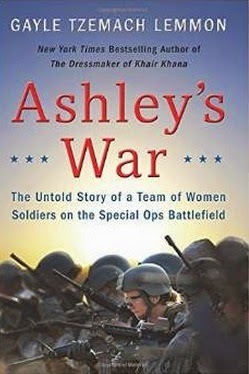 On April 21, 2015, the book, "Ashley's War: The Untold Story of a Team of Women Soldiers on the Special Ops Battlefield" by Gayle Tzemach Lemmon was released in bookstores and through online retailers across the US. While the book has been much anticipated - not to mention there was a recent bidding war where Reese Witherspoon won the opportunity to produce the film adaptation - there has also been a downpour of negativity from men around the US, many of whom claim to be US military veterans.
On April 21, 2015, the book, "Ashley's War: The Untold Story of a Team of Women Soldiers on the Special Ops Battlefield" by Gayle Tzemach Lemmon was released in bookstores and through online retailers across the US. While the book has been much anticipated - not to mention there was a recent bidding war where Reese Witherspoon won the opportunity to produce the film adaptation - there has also been a downpour of negativity from men around the US, many of whom claim to be US military veterans.While homelessness, suicide, combat-related PTSD, and other military service-connected ills plague the female veteran community, the antiquated views seen on social media about women help perpetuate this diabolical trend. In a time like this, and with the release of "Ashely's War", women veterans should be able to anticipate support from veteran service organizations (VSO's). Yet that doesn't appear to be happening.
Below are the screenshots of the response to "Ashley's War" on Iraq and Afghanistan Veterans of America's (IAVA) Facebook page. Their lack of moderation or speaking out in defense of female combat veterans is quite chilling.
(Click on images to enlarge)
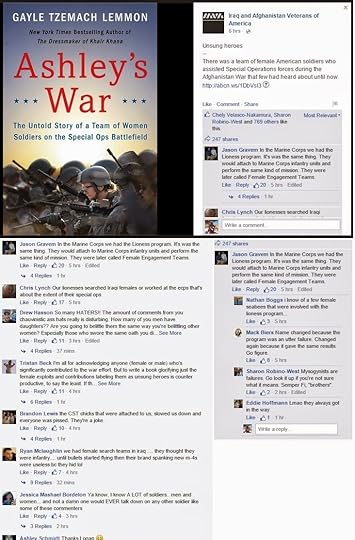
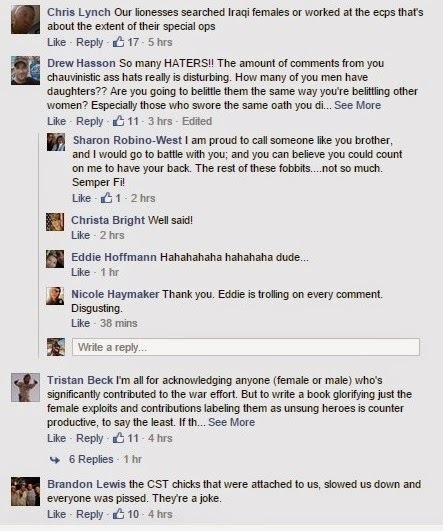

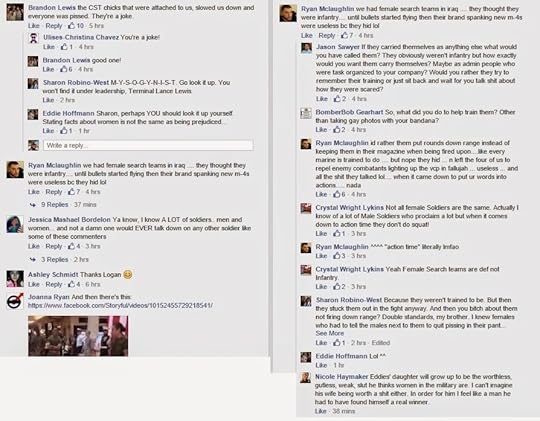
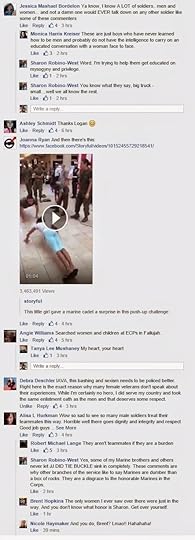



With so-called brothers like these, who needs enemies?
When such misogyny is not addressed by such VSO's, and VA healthcare fails to meet the needs of returning women veterans who've been fighting and dying since the beginning of these recent wars in Afghanistan and Iraq, the silence of our supposed allies becomes deafening. Unfortunately, the war doesn't end when we come home and this especially rings true for women who have served in combat without the credit or respect upon return to the US.
What do the above screenshots say - and bear in mind this is just one thread on one VSO's Facebook page - about how the US treats its female veteran population?
April 23, 2015
A Quick Twitter Discussion Regarding the Female Combat Veteran Voice

Well, I guess it's easier to focus on the positive as a privileged senior fellow on CFR, and applauded for telling the stories of women combat veterans.
However, this task becomes increasingly difficult when you have been waiting 10 years to be treated with some dignity or see any benefits from VA, who still calls you "Mister" and has no clue what women have been doing overseas for years.
It's easier to focus on the positive when one has access, privilege, and is not the direct target for slander, persecution, and ostracization.
While I appreciate those allied with female combat veterans, one also must point out this blatant issue of intersectionality and whose voice is truly being heard. And when the direct input of female combat veterans is muted or snuffed out, it is allies like this who must speak up as they do, in fact, profit from our stories.
Photo: From a Twitter convo with "Ashley's War" author, Gayle Tzemach Lemmon.
March 24, 2015
Do You Have Any Chapstick? But This Reintegration Process Hurts Real Bad!
 Aside from the old Lioness pic of mine getting circulated, I recall the time when I started showing photos of Iraq to other people. When I showed it to a class on war and violence at UNF in Jacksonville, the only questions I got were whether or not I was wearing makeup. Really. It wasn't about the collage of dead Saudi bodies, the hungry children begging for food, or the apocalyptic crisis that was Iraq's Anbar Province in 2005. No, the important thing both male and female students thought to ask was if I was wearing lipstick or chapstick in my photos. Yeah, my desire not to have chapped lips in a fucking desert is way more interesting than thousands of people dying, a country being dissolved into nothingness, and intense urban warfare.
Aside from the old Lioness pic of mine getting circulated, I recall the time when I started showing photos of Iraq to other people. When I showed it to a class on war and violence at UNF in Jacksonville, the only questions I got were whether or not I was wearing makeup. Really. It wasn't about the collage of dead Saudi bodies, the hungry children begging for food, or the apocalyptic crisis that was Iraq's Anbar Province in 2005. No, the important thing both male and female students thought to ask was if I was wearing lipstick or chapstick in my photos. Yeah, my desire not to have chapped lips in a fucking desert is way more interesting than thousands of people dying, a country being dissolved into nothingness, and intense urban warfare.I could have been standing on the bludgeoned carcass of the Kraken from "Clash of the Titans" while holding the cure for cancer in one hand, and the recipe to Colonel Sanders' chicken in the other, and people would still find a way to put me down, negate my service, and continue to make the US female veteran reintegration experience a negative one.
The fact of the matter is, people in the United States - mostly men, but a few women who are embracing internalized oppression with pizzazz - have an easy time tearing women down when they're appearing to be strong, then posting women half-naked holding rifles and screaming 'Murica. As a result, women veterans face additional discrimination or complete barriers in accessing deserved benefits while being openly, and sometimes publicly, humiliated for their service and having two X chromosomes. Thank you, America. No one says "welcome home, soldier" better than you...unless you're a woman, minority, LGBTQ or anything else not fitting the straight Aryan male mold. Thanks.
March 3, 2015
Patient Profile #1: The Survivalist
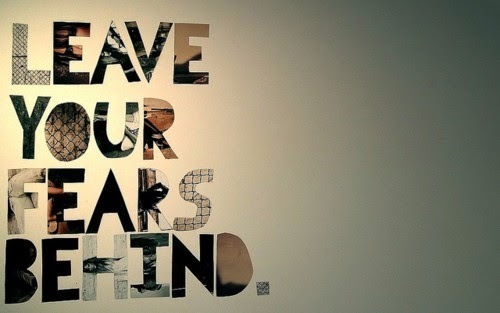 This story is part of a series called "Counseling on the Battlefield" where real-life excerpts of counseling sessions that were conducted during the Iraq war in 2004-2005 were documented in my travel journal, with actual clients remaining anonymous through random, unrelated patient numbers to protect confidentiality. While serving in Ar Ramadi, Iraq, in addition to serving on Team Lioness, I was also the Camp Ar Ramadi Combat Stress Control Non-Commissioned Officer In-Charge - which translates into be being the clinic supervisor while the staff psych nurse disappeared for most of the day. To read all the patient profiles and the adventures (and really terrible misadventures), pick up a copy of my book, "Quixote in Ramadi" to truly dive into the bizarre world of military mental health and combat stress control. Enjoy.
This story is part of a series called "Counseling on the Battlefield" where real-life excerpts of counseling sessions that were conducted during the Iraq war in 2004-2005 were documented in my travel journal, with actual clients remaining anonymous through random, unrelated patient numbers to protect confidentiality. While serving in Ar Ramadi, Iraq, in addition to serving on Team Lioness, I was also the Camp Ar Ramadi Combat Stress Control Non-Commissioned Officer In-Charge - which translates into be being the clinic supervisor while the staff psych nurse disappeared for most of the day. To read all the patient profiles and the adventures (and really terrible misadventures), pick up a copy of my book, "Quixote in Ramadi" to truly dive into the bizarre world of military mental health and combat stress control. Enjoy.PATIENT PROFILE #1: THE SURVIVALIST
While we had a steady flux of patients coming into the clinic, many of which were cases we were taking over from the 587th, there are only a few I have chosen to focus on so you could have a decent idea of the multiple issues that were faced and the diversity of problems one can undergo in a combat theater. On average, I could say each of us saw about two to three patients a day, seven days a week. We could see groups of five to a few hundred for briefings. We had no days off as directed by CPT Jack despite the Major’s suggestion to do so as he did for his team.
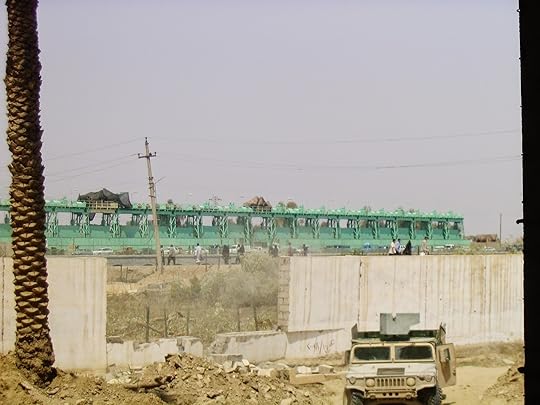 This was my first interview with a patient in Ramadi, one of SGT Daniels’ patients. “You’re going to love this guy, just fucking hilarious!” said Daniels enthusiastically as we waited for Patient #1 to roll through the door. Since I can’t use names for various reasons, I’m simply going to number those we saw to avoid any confusion and to protect their privacy. Along the same lines of privacy, there are a few things I’ve changed from each person’s story to make them unrecognizable to those who currently work with them. I know it seems sterile as every one of these patients are real people with real names, but with the other patients I’m going to mention, it will be much easier to keep track.
This was my first interview with a patient in Ramadi, one of SGT Daniels’ patients. “You’re going to love this guy, just fucking hilarious!” said Daniels enthusiastically as we waited for Patient #1 to roll through the door. Since I can’t use names for various reasons, I’m simply going to number those we saw to avoid any confusion and to protect their privacy. Along the same lines of privacy, there are a few things I’ve changed from each person’s story to make them unrecognizable to those who currently work with them. I know it seems sterile as every one of these patients are real people with real names, but with the other patients I’m going to mention, it will be much easier to keep track.Patient #1 casually strolled through the door, Daniels introduced us, and each of us grabbed a fold-out chair and followed Daniels to the roof. Well, Daniels was right, this kid was a riot. As I was sitting with Daniels, trying not to laugh at how animated this guy was, he told me quite an amazing story of what life was like for him on a daily basis outside the wire in Ramadi. Outside the wire is a term meaning anywhere outside an encampment or military base.
Some people go their entire deployments without ever going outside the wire. Daniels asked him to tell his story since I’d be taking over as his new counselor and the clinic supervisor so he did just that, but in the most entertaining way possible. Although the theatrics weren’t needed, being such an incredible story, you could tell this was a person who could be destined for stand-up comedy who now just happened to be wearing a US Army uniform.
 He spoke with a voice of both rage and irony, seasoning each sentence with laughter and frustration of all the asinine things he’s seen from incompetent leaders to the most dangerous mix-ups in communication. One in which almost cost a fellow soldier’s life in a firefight out in town.
He spoke with a voice of both rage and irony, seasoning each sentence with laughter and frustration of all the asinine things he’s seen from incompetent leaders to the most dangerous mix-ups in communication. One in which almost cost a fellow soldier’s life in a firefight out in town.During a patrol through the streets of Ramadi, Patient #1 and a few Soldiers from his unit were ambushed and driven to the inside of a bombed-out building to take cover and return fire. To make matters worse, on the other side of this firefight, a Marine unit started firing in the opposite direction, streaming bullets in not only the path of insurgents but this Army unit as well. While the opportunity was present and the enemy was suppressed, everyone jumped into the track vehicle and high-tailed it out of there in order to catch up with the rest of their unit.
At the very last moment upon reaching their company, they realized everyone wasn’t accounted for: one of their soldiers was missing. This battle buddy who was left behind, realizing the danger grew exponentially for him as he was left on his own, ran down street after street looking for anyone from a US military unit, but was apparently out of luck. He immediately took refuge in a field of tall grass as groups of insurgents performed what looked like a manhunt for the odd guy out. He then seized a moment when the insurgents passed and commenced to make a mad dash for the front gate of Camp Ramadi, which was miles away. He succeeded in making it to less than a mile outside the gate before his company finally picked him up.
 The reason why Patient #1 was here? He confronted, and quite possibly threatened bodily harm to his commander for repeated poor decisions much like the one that put them in unnecessarily compromising positions, causing them to fight on their own with no outside support and poor communication that caused Marines, who were unaware of their position, to fire at them.
The reason why Patient #1 was here? He confronted, and quite possibly threatened bodily harm to his commander for repeated poor decisions much like the one that put them in unnecessarily compromising positions, causing them to fight on their own with no outside support and poor communication that caused Marines, who were unaware of their position, to fire at them.He came here for anger management, but mostly I saw this as his opportunity to vent instead of taking out his frustrations on people who could certainly charge him for insubordination on a criminal level. I could understand anyone in such a situation could react like that, and he was willing to accept responsibility for his fully-forgiving, abandoned battle buddy.
 Patient #1 wasn’t the only one who came to our clinic complaining about their ineffective and hopeless commander. In fact, his Army Engineering unit ended up being our #1 customer at the Ar Ramadi Combat Stress Clinic. It appeared that this particular company, and their steady stream of clients, was not a mere anger management group or those in need of positive coping mechanism instruction; this was an ongoing homicide prevention campaign in which the incompetent commander was constantly the target.
Patient #1 wasn’t the only one who came to our clinic complaining about their ineffective and hopeless commander. In fact, his Army Engineering unit ended up being our #1 customer at the Ar Ramadi Combat Stress Clinic. It appeared that this particular company, and their steady stream of clients, was not a mere anger management group or those in need of positive coping mechanism instruction; this was an ongoing homicide prevention campaign in which the incompetent commander was constantly the target.After the 587th left, Patient #1 and I continued our talks on the roof despite the occasional interruptions of hurdling rockets and mortars that pounded our camp daily. He liked the roof, as did I. It was more private and even when IED’s were going off at the gate which was within our view; it still managed to be oddly tranquil. Perhaps it was seeing the cold blue sky and doves flying around, as opposed to the cramped and sandy clinic interview room right below us, that was comforting. He talked, I listened. As we delved further into his story and his life, it was soon my turn to go outside the wire, which forever changed both of us.
February 16, 2015
Between a Rock and a Car: A Childhood Memory on Racism
 When someone disrespects you to your face or about you behind your back, you don’t have to accept it. You have to agree with that perception before the idea becomes a part of you. You always have to ask, “Who are you to tell me who I am?” What happens when you tell a child, over and over that they’re stupid, worthless, and unloved? They’ll grow up believing it, and they will act in accordance with who they think they are, no matter how erroneous that negative commentary was. Here is a childhood "flashback" from my book, "Quixote in Ramadi".
When someone disrespects you to your face or about you behind your back, you don’t have to accept it. You have to agree with that perception before the idea becomes a part of you. You always have to ask, “Who are you to tell me who I am?” What happens when you tell a child, over and over that they’re stupid, worthless, and unloved? They’ll grow up believing it, and they will act in accordance with who they think they are, no matter how erroneous that negative commentary was. Here is a childhood "flashback" from my book, "Quixote in Ramadi".After moving from Key West at age four to Edgewater, Florida, we bought a house that was located in a small development that was filled with retirees. One woman across the street, Mary, who was an Irish immigrant, was quick to greet us and we instantly took a liking to her. She would dote on my sister and I and spend hours chatting with my mother about how life was in Ireland and my mom would openly and comfortably discuss her life growing up in Saipan.
However, not everyone in the neighborhood was so welcoming. The neighbor to our right, named Rose, was an elder German immigrant, and while she invited my mother over a few times to chat, she became openly militant about immigrants in this country. This was quite hilarious to my mother as her islands were owned by the US and she was therefore an American citizen from birth as well as an indigenous Chamorro and here was this angry woman from Germany, shouting about foreigners.
While my mother initially brushed off her racist remarks, it didn’t take long for her to put Rose in her place. Soon after, Rose began burning trash in our back yard then calling the fire department and police on my parents, claiming we should be removed from the neighborhood.
One evening as my older first cousin, Ramona and her husband were visiting from South Carolina, we caught Rose dumping garbage onto our front yard as we sat outside. My mother then launched up from her chair, followed by my cousin Ramona, and walked over to Rose. I ran after them, feeling the need to protect them.
“You know, if you hate it here so much, why don’t you go back to your country? If anything, you’re the annoying foreigner who’s bothering everyone,” my mother said, seemingly ready and willing to give her another dose of her own medicine.
“You disgusting fucking n***er! Go back to where you came from, you goddamned monkeys! This is a white’s only neighborhood!” Rose shrieked as she threw her lit cigarette at my mother.
In a split second, my cousin Ramona, who’s barely five feet tall, but a spunky Chamorrita, reached over the small, rickety wooden dividers on our lawn and grabbed Rose by the hair and began punching her in the back of her head.
“NO, MONA, STOP IT! SHE’S AN OLD WOMAN!” by mother cried as Ramona held the sobbing Rose in her left hand and pointed in her face with her right.
“You say one more word and I’ll kill you,” Ramona said to Rose while my mother now was pleading with Ramona to stop as my father, Ramona’s husband, and my sister raced toward us to calm Ramona’s temper.
“Please, let her go, it’s not worth it,” my mother begged Ramona, who then pushed Rose back onto her own lawn.
“You want to fuck with Chamorros, you old Nazi bitch, that’s what you get! You might’ve gotten away with that bullshit when you were Hitler’s whore, but you’re sure as fuck not pushing us around!” Ramona laughed as Rose held her battered face, glaring back in defeat.
“Who’s Hitler?” I asked my sister, who then elbowed me and told me to just keep quiet.
While Rose fled to her house, my parents and Ramona’s husband consoled Ramona and advised her that Rose could call the police and instigate even more problems that none of us wanted. The police were, of course, called and two cars showed up with black and white male officers. When we explained what happened, the police surprisingly did nothing to Ramona and instead reaffirmed that Rose’s continued harassment of our family was going to cost her if it didn’t end today.
Rose’s repeating the N-word to the white officers didn’t help her case either to say the least. My father and Ramona’s husband then laughed at the insanity of Chamorro women and how they taught Rose a new lesson in world history in a few swift punches. A week or so went by and Ramona and her husband drove back to South Carolina and there wasn’t another peep out of Rose.
Weeks after the Chamorro-German brawl, one day after school when the bus dropped my sister and I off near our home, Rose’s granddaughter, Shannon, came up to us, pulled my braided ponytail and called me the N-word again. It’s crazy that even at that age, I had become so familiar with such a profane racial slur and it came out of these people’s mouths so easily, like it was part of their breathing.
The walk from the bus stop to the house was a hundred fifty meters maximum, but she did this just ten steps after the bus pulled away. My sister dropped her backpack and began to chase Shannon into the woods, yelling at her for being a coward. I ran back to our house as fast as I could and screamed for my mother who then ran with me out of the house and towards Janice. Shannon apparently went hiding in the woods and Janice, who seemed to have fallen over a tree stump, came walking out, dusting herself off from the dirt and pine needles.
My mother asked what happened and was furious. We stood there for a few minutes as she dusted Janice off and then we began walking back toward our house. That’s when Shannon immediately sprung from the woods and ran into her grandmother’s house. Rose came out in no time, got in her car and drove as fast as she could past us.
“I’m getting really, very sick of that woman,” my mother grumbled.
All of a sudden, we heard a screech behind us, then an engine revving louder and louder. Rose was driving toward us as fast as she could. Just in time before we could be hit, my mother picked up my sister and I and threw us to the side and into the dirt. Rose, thankfully, missed. In a state of rage, my mother grabbed rocks and started hurling them at Rose’s car and screamed obscenities in Chamorro. I'll always remember that moment. No matter how many rocks my mother threw at the machine and the white supremacists operating it, it was never enough.
Rose peeled away with Shannon and disappeared for hours. Mary, and other concerned neighbors, came out to ask what had happened and were appalled by Rose’s persistence in menacing our family. The police were called, yet again, and another report was taken followed by another visit to Rose’s home when she returned. It wasn’t too long after the incident that my father accepted orders to relocate. This time, it was Alabama.
For the rest of this story, read "Quixote in Ramadi".
January 30, 2015
Army Suicide Prevention Quiz
 As I go through old military mental health files, I'll continue to post different training materials, presentations, and fact sheets to assist you in understanding various military and civilian mental health issues (but, with updated statistics). If you have any requests for any specific military or veteran mental health related topic, please comment below.
As I go through old military mental health files, I'll continue to post different training materials, presentations, and fact sheets to assist you in understanding various military and civilian mental health issues (but, with updated statistics). If you have any requests for any specific military or veteran mental health related topic, please comment below.For more information on the US military veteran suicide epidemic, click here.
Suicide Prevention Quiz
Take this quiz to test your knowledge.
Circle “T” for true, “F” for False.
1. Of any 10 persons who kill themselves, 8 have given definite warnings of their suicidal intentions. T F
2. Spring and Mondays are have the highest numbers of suicides. T F
3. A history of past suicidal attempts is sad, but not useful in predicting future attempts. T F
4. Suicide rates are higher among the 15-24 year old age group. T F
5. Suicide is not ranked in the top ten causes of death in the United States. T F
6. There are three attempts at suicide for every one completed suicide. T F
7. Individuals who attempt to kill themselves are suicidal for limited time periods only. T F
8. Improvement following a suicidal crisis means that the self injury risk is over. T F
9. Studies of hundreds of genuine suicide notes indicate that although the suicidal individual is extremely unhappy, he or she is not necessarily mentally ill. T F
10. Suicide rates are higher in the military than civilian sector. T F
11. Women attempt suicide as often as men in the United States. T F
12. At one time or another, almost everyone contemplates suicide. T F
13. Most suicidal persons who die did not have mixed feelings about living or dying. T F
14. Almost no one commits suicide without letting someone know about their intentions. T F
15. All verbal indications of suicide intent should be taken seriously. T F
16.If one suspects that a person is thinking about suicide, asking about it may cause the person to commit suicide. T F
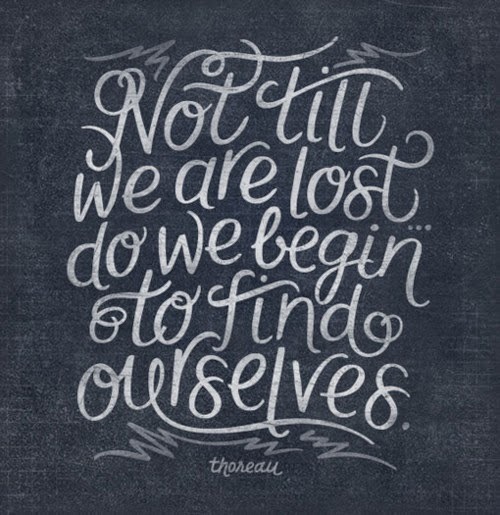
To Discover Your Score, Read On!
Adapted From: American Association of Suicidology and NIH Pub# 82-2308, Aug 81, “Suicide Prevention”.
Answers to the Quiz:
1. True.
2. True.
3. False. A history of past coping behaviors (including suicide attempts) is a good indicator of future coping behavior.
4. False. Suicide rates are highest among those over 65 years old. Their rates tend to be more than 50% higher than the national average and that of 15-24 year olds.
5. False. Suicide ranks in the top ten causes of death. For 15-24 year olds it is third following accidents and homicides.
6. False. Estimates vary, but generally there are 8 to 20 attempts for every completed suicide.
7. True.
8. False. Often the person is at greater risk of suicide when they appear to be improving. For depressed people, as they improve they now have the energy to act on their depressed feelings.
9. True. However, mental health diagnoses (e.g., depression, schizophrenia, alcoholics, and panic disorders) are associated with greater risks of suicide.
10. False. The suicide rate in the military is generally the same as in the civilian sector. However, over the past 8 years it has risen from 11.7 per 100,000 to 14.2 per 100,000.
11. False. Risk of attempted suicide is greater for females and the young. Females generally make 3 to 4 times as many attempts as males. Males tend to choose more lethal and successful methods.
12. True. Given enough stress, almost all of us consider suicide as an option.
13. False. Most people who are suicidal are unsure about whether to live or die.
14. True. One of the commonalties of suicide is the communication of intent.
15. True. Especially higher functioning individuals are less likely to convey their intent. Any hints should be taken seriously. Do not be afraid to ask!
16. False. Instead, asking the person and expressing concern may save their life.
Spring, the season of new life is when most suicides occur. Suicide is one of the top ten causes of death in the United States. It ranks as the second leading cause of death among those 15 to 24 years old. In 2013 alone, over 41,000 persons killed themselves; that is one suicide every 12.8 minutes. Almost everyone has thought about suicide, but no one needs to die by their own hand. Suicide is preventable, if you watch for the warning signs, stop to ask a few questions, and take the time to help. For more information on up-to-date US-based suicide statistics, click here.
Here are a few key points to help guide your questions and some suggestions on how to help.
Don’t be afraid to ask!
People attempt suicide for a number of reasons. Those who are at the greatest risk of self-injury are emotionally upset over work problems, a relationship that is in trouble, or a major life change. They may blame themselves and allow self-hate, self-blame, guilt and shame to fester. They withdraw from others and outside activities. They develop tunnel vision as their hope narrows--all they can see is continued suffering. Finally, there is the thought that ceasing to be would stop the pain.
What are the Signs of Suicide?
Most people who attempt suicide really do not want to die. They are asking for help. Eight out of ten people who commit suicide have indicated to someone their intention of killing themselves. As a rule, if you can lower the emotional distress that has led someone to consider suicide, you will also lower their risk of committing suicide.
Watch for these Warning Signs:
Confusion Financial Reversal or Loss of Social Status A Family History of Suicide Previous Suicide Attempts Feelings of Failure Talk About Death or Committing Suicide Lack of Roots or Social Relationships Over Emphasizing a Lack of Suicidal Thoughts Withdrawal from Others and Outside Activities Recent Break-up of a Significant Relationship
Suicide Prevention Tips
You can help prevent a suicide by asking a few important questions.
1. What is going on?
2. Where do you hurt?
3. What would you like to happen?
4. What do you feel that you have to solve or get out of?
5. Do you have any plans to do anything harmful to yourself and what might you do?
6. What would it take (to keep you alive)?
7. Have you ever been in a situation like this before, what did you do, what happened, and how was it resolved?
For More Information and Help
If you need help or you are concerned that someone you know may be at risk of suicide, there are caring professionals who are there to help. Please contact your nearest qualified mental health professional, go to the Emergency Room, or call 911. There are people who care.
Summing it Up
The American Association of Suicidology advises:
Believe It. Take any signs or threat of suicide seriously. Listen Carefully. Keep the lines of communication open, ask questions, and talk calmly. Be sympathetic. Don’t be judgmental or give false assurances that everything will be all right. Get Help. Call a suicide prevention center, mental health clinic, physician, chaplain, or other qualified mental health professional. Be There. Be supportive and show that you care. Do not leave him or her in a crisis. Follow up by staying in touch and encouraging him or her to continue treatment.
For more information:
Directory of AAS-Accredited Crisis Centers
Don't see a local number?
The National Suicide Prevention Lifeline can connect you to a local crisis line 24 hours a day, 7 days a week.
1-800-273-TALK (8255)
www.suicidepreventionlifeline.org
My Take on "American Sniper"
 Above Right: Chris Kyle Photo Courtesy of DallasNewsBlogs
Above Right: Chris Kyle Photo Courtesy of DallasNewsBlogsIf people are startled by Chris Kyle’s jingoism or apparent xenophobic hostility in his book, now being glorified in a Hollywood film, maybe it'd be better to think harder before sending people into combat on dubious grounds, selecting people who are not Axis II and/or bigots to enlist or join the officer corps, and having a better grasp on what combat entails with regard to long-term damage, trauma, and aftermath. But then again, critical thinking in terms of foreign policy is not a strong suit of the general American public or politicians.
One could view the film as mere entertainment or even propaganda, but let us not forget that Chris Kyle wasn't a character, but a real person in a war many of us remember quite vividly. His book was written with the assistance of ghost writers and it read in an over-simplistic tone, insisting that the Iraqis he was fighting against were "savages." Funny, in Anbar Province, during the Iraq war in 2004-2005, most of the insurgents were Saudi (around 85%). His book conveniently discards such information - or perhaps all these "savages" were the same in the lens of his scope. Forget our interpreters, the innocent people who just wanted to live their life without an oppressive leader or invading foreign military. "American Sniper" surely points out the absurdity and hypocrisy of the term "Operation Iraqi Freedom."
The film goes on to undermine the competence of Marines operating in Anbar which is pretty insulting to insinuate through this rabid piece of hero porn. It's not a film about the cost of war, PTSD, or anything of value. It's not a film that goes deep in to the trenches of a war-embattled mind. It's Chris Kyle’s posthumous video resume that is more suitable for Zappos human resources than any collection of films with an introspective take on war. The reasons we went to Iraq, and the misconceptions raised in the book are hardly addressed, and the film does well to skip on by those points as well.
This is not a critique as to whether this film is "pro-war" or not, this is about hindsight. It's "lovely" to see all the reactions and concern over why we went to war and what that entailed well after the fact, but that's the problem. Why does anyone care now, and not when this was happening? Shallow depictions of war and shallow patriotism make a great recipe for complacency.
So wave your flags and stuff your face with apple pie until type 2 diabetes sets in, because veterans are taking their own lives at 22 per day, sexual assault in the Armed Forces is traumatizing men and women everywhere, and the VA is "accidentally" giving people Hepatitis C and HIV and dragging their feet on claims. No, no, don't worry your precious little head about having any real conversation about sociopaths in uniform, people who should have been screened at MEPS (and NOT wait until they lose their shit in theater), and politicians who've failed us due to the sleepy consciences of our citizens. No, please, have some more pie and keep dreaming that everything is okay.
This is not the "American Sniper" perspective that speaks for me as an Iraq war veteran. Clint Eastwood did well in profiting off our pain, yet again, without addressing the ills plaguing the American veteran community today. However, if you do want to read about a perspective that honestly addresses the aftermath of war and its morality, read up on Garett Reppenhagen, the "American Sniper" you didn't hear about. Or even Alex's Horton's take on "American Sniper" feeding America's hero complex. I'd rather you hear them out than to believe we are all Chris Kyle or share his views on the Iraq war.
"American Sniper" was not easy for me to read and triggered a lot of anger over what I had faced in Iraq due to racial discrimination and persecution. I cringed, page after page, through the book. It read more like "Dick and Jane go to Anbar" - except Jane is a "savage" that he's looking forward to mowing down along with her children. If you walk away from this post with anything, please let it be that you see the other side of the story when it comes to the veteran's take on war, and that there are many of us who didn't embellish our service, dehumanize Iraqis, and relish in sociopathic glory. None of us - with a conscience at least - feel great about how the Iraq war started, marched on, and ended. It is our nightmare and it has ruined the lives of millions and will never leave us. I only hope that such a catastrophic and pointless war will teach us something of value, and it is not the glorification of combat.



